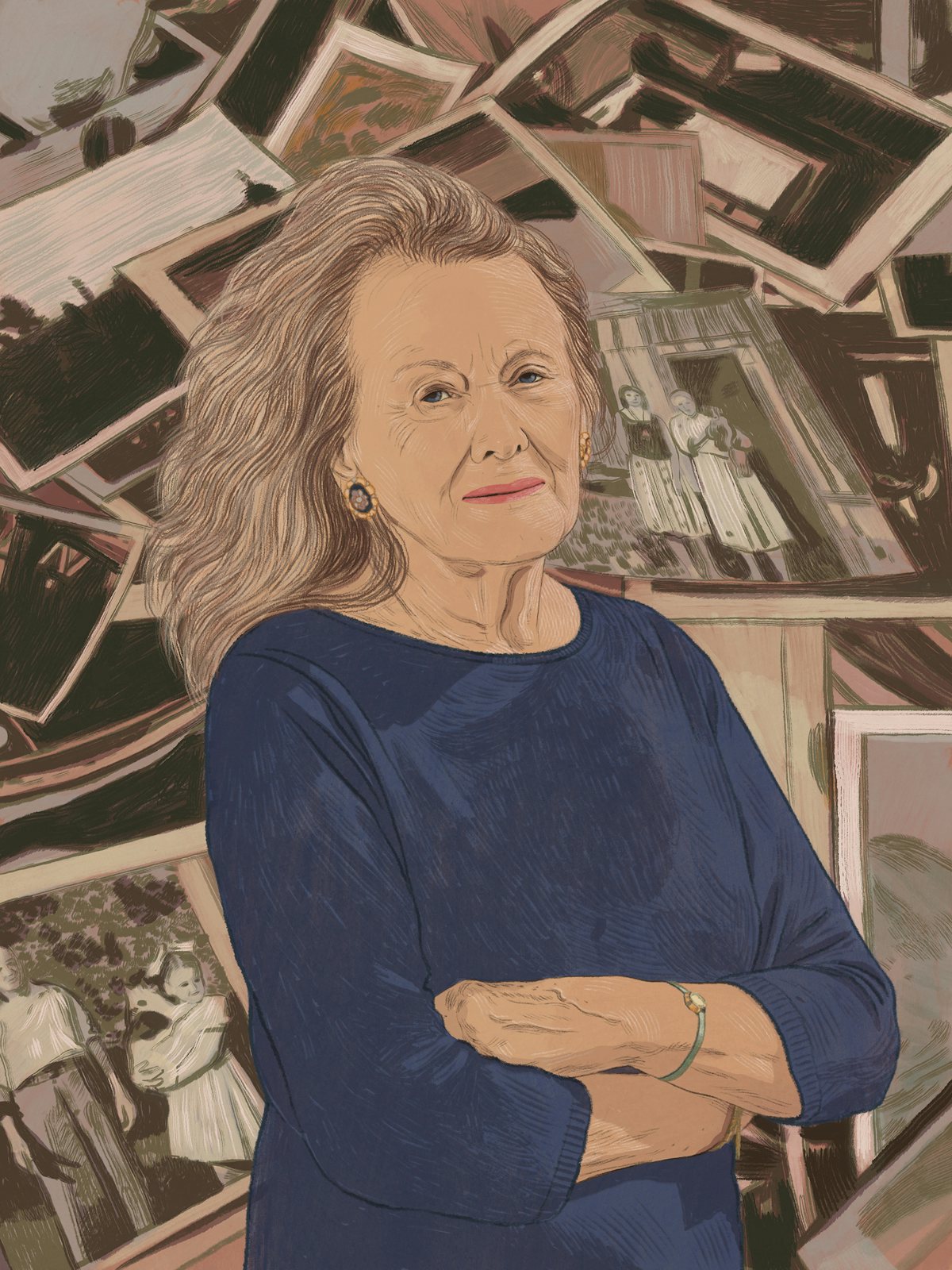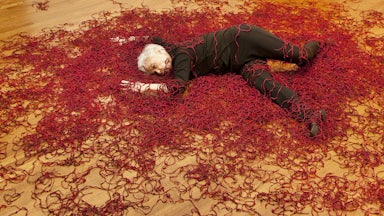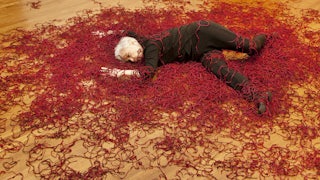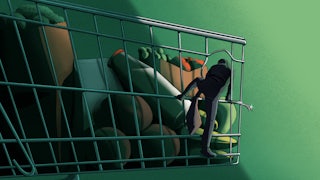What more can be said about Annie Ernaux, novelist, memoirist, leftist, reluctant member of the French literary elite? Since she won the Nobel Prize in literature in October 2022, she’s been fêted and interviewed, profiled and praised. Best known for her short, spare memoirs, she has been credited with reinventing the genre. While many other memoirists may work like stenographers, describing life in exhaustive detail, Ernaux, the critic Alexandra Schwartz has observed, “is more like a diver, glimpsing something glimmering far beneath the surface of consciousness and plunging after it.”
Most of Ernaux’s books focus on a specific period or episode in her life—a passionate love affair, a domestic dispute between her parents—which she then analyzes intensely, sometimes consulting photographs, newspapers, or journal entries. Starting with her first memoir, A Man’s Place (1983), the story of her father, Ernaux has taken an ethnographic or sociological approach to writing: Whether describing her parents, her lovers, or herself, she shows how any individual is embedded in, and shaped by, social and historical circumstances. She often revisits a single incident several times, across multiple books, each time finding new material to interpret and new meanings to unearth.
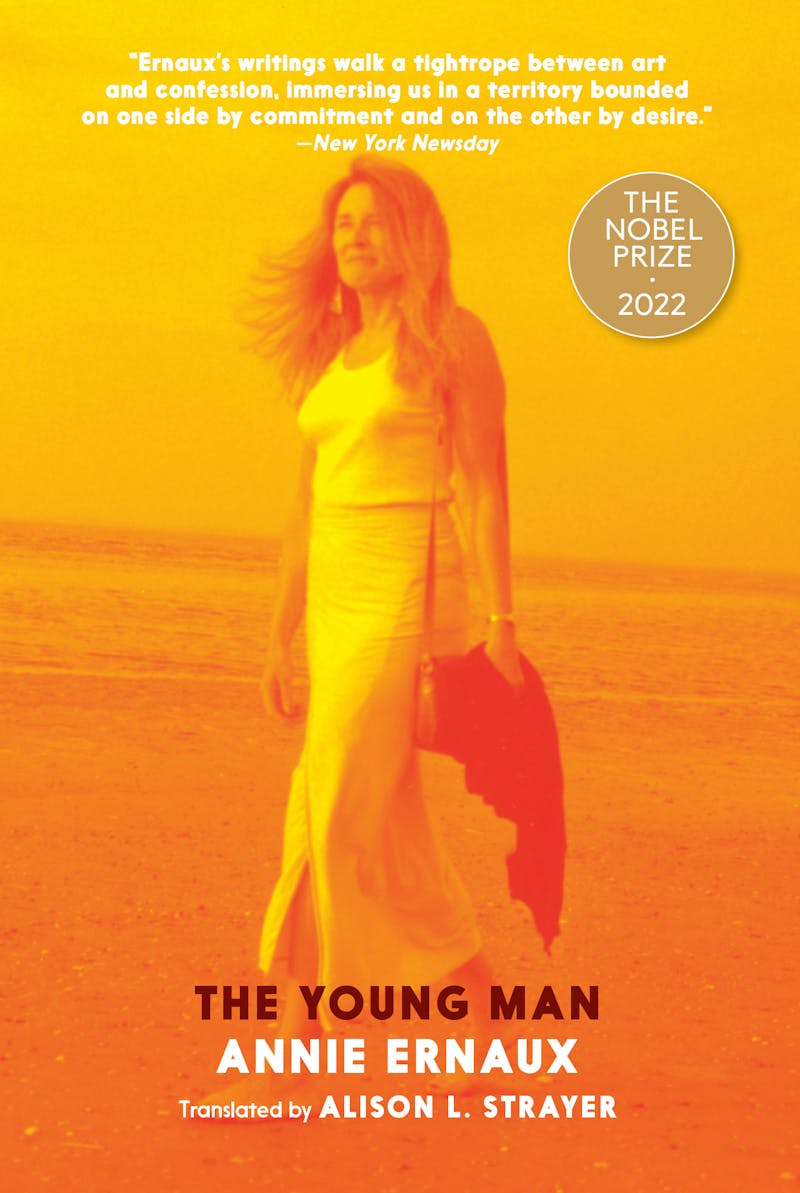
Over the course of some 20 books, Ernaux has written and rewritten the story of her life and, at the same time, the story of her generation. And yet the books just keep on coming—no small feat for a writer in her early eighties. Some of these books were written years ago and are now newly translated into English; they join the handful of titles translated by Carol Sanders and Tanya Leslie in the 1990s and early 2000s. In April this year, Yale University Press published Alison L. Strayer’s English translation of Look at the Lights, My Love, a meditation on the French hypermarché, or superstore. Observing her fellow shoppers at the Auchan superstore in Cergy-Pontoise, Ernaux is at her most sociological, noting how working-class people shop carefully, as if scared to miss a potential sale, and how the clearance section is five times larger than the section devoted to gourmet foods. Her latest, The Young Man, also translated by Strayer, moves Ernaux back toward the personal end of the spectrum, telling the story of her affair with A.—a student roughly 30 years her junior. Like many of her books, it shows how sex and writing are intertwined for Ernaux, the one compelling—or sometimes impeding—the other.
New Ernaux is never entirely new, which makes her long career strangely difficult to interpret. Typically, a literary critic proceeds chronologically, comparing an author’s recent work to earlier work, and tracing the evolution of a writer’s style and themes over time. Ernaux thwarts this approach. As Jamie Hood and Joanna Biggs have each noted in their essays on Ernaux, her books are full of repetitions and recursions; they are not so much discrete stories as fragments of one endlessly expanding story, a kind of “total novel,” as she puts it in The Years (2008). Memory, the narrative present, and the time of writing blend into one continuous timeline, stretching across different books. To read Ernaux, and to write about her, mean becoming comfortable with repetition. Her memoirs ask us to cultivate different expectations for narrative, and perhaps for life: to seek not novelty but rather the familiar, which surprises in its own way.
Born in 1940, Ernaux began to write in earnest in her early thirties, when she was already married with two sons and teaching high school. She worked furtively, in moments stolen from family commitments and her day job. (Wary of relying on book sales for a living, Ernaux kept her day job as a teacher for decades, even after she’d achieved literary renown.) She found the writing of fiction freeing: “The mask of fiction removed all kinds of inner censorship,” she once wrote, and “allowed me to push all the boundaries and expose what remains unspoken.” She could always deny that the first-person narrator of a novel was her, despite any apparent resemblances. Her debut, Cleaned Out, in which a college student undergoes an illegal abortion, was published in France in 1974. Two more autobiographical novels followed. Meandering and philosophical, these books take up many of the same subjects that her later memoirs do—memory, marriage, reproductive life—though they have a lyrical quality that Ernaux would later renounce.
Not long after the publication of her third novel, A Frozen Woman, in 1981, Ernaux separated from her husband, Philippe, whom she’d married while pregnant with their first son in 1964. The separation offered her a different kind of freedom: the space to write about her father, who died from a sudden illness three years after her wedding. Though the book started out as a novel, Ernaux soon found fiction, with its drama and lyricism, inadequate. “If I wish to tell the story of a life governed by necessity, I have no right to adopt an artistic approach,” she explains in A Man’s Place. She turned to memoir—and to a style that she calls “écriture plate,” an unadorned, factual tone—out of a need to show her father as he was, or at least as she remembered him to be.
To do this, she toggled back and forth between the personal and the social—or, to put it more specifically, between presenting her father as a unique individual and presenting him as a social type. Born in a small village where nearly everyone worked the land, he had known a life of hardship: the difficulties of farming, the deprivations of World War II. A working-class man who tried not to look working-class—“to look more like a shopkeeper than a worker,” Ernaux writes—he exchanged a life in the factory for one behind the counter of the small grocery store and café that he owned, with Ernaux’s mother, in Yvetot in northern France.
Much of the book is given over to the dispassionate recording of her father’s habits and behaviors. He didn’t drink; he invariably cleaned his plate. He drank his coffee with a spoon, and he could recognize birds by their songs. These characteristics are particular to Ernaux’s father, yet they might equally apply to many men of his generation, region, and social class. How many other men in postwar Yvetot “spat and sneezed with relish,” or ate their dinners with pocketknives? Should the story of a life comprise subjective memories—what Ernaux calls “personal reminiscence”—or should it rather be an objective, sociological account of a person born in a specific place and time? This is the central tension of the book, and it courses through nearly all her memoiristic writing.
There is another tension, too: between the past self who experiences and the present self who analyzes. This is a tension found in most memoirs, or at least in most good ones, but it’s particularly acute for Ernaux, who, through scholastic achievement, ascended to a different social class than her parents’. “As I write, I try to steer a middle course between rehabilitating a lifestyle generally considered to be inferior, and denouncing the feelings of estrangement it brings,” she writes. There are moments when we feel Ernaux mocking or disapproving of her younger self, such as when, on a visit home, she tries to impress her parents by describing the well-appointed apartment that she and her husband shared, though “the antique dresser and the Dunlopillo mattress meant nothing more to [her father] than the signs of social success.” (He cuts her off, saying uncomprehendingly that she should “make the most of it.”) Of all Ernaux’s books, this one most powerfully displays her ambivalence about her own social mobility.
Ernaux returned to Yvetot in her next book. She describes A Woman’s Story (1988), about her mother, as “a cross between literature, sociology, and history” and herself as a kind of “archivist,” recording and cataloging the habits of a social world to which she no longer belonged. When her mother dies after years of suffering from Alzheimer’s, she feels, as she writes in the book’s final sentence, that “the last bond between me and the world I come from has been severed.” But nearly a decade later, Ernaux went back to the last years of her mother’s life, publishing the journals and notebooks she kept during that time, I Remain in Darkness. Although Ernaux hadn’t anticipated publishing the journals, she later changed her mind: “I have come round to thinking that the consistency and coherence achieved in any written work—even when its innermost contradictions are laid bare—must be questioned whenever possible.”
This is one way to understand Ernaux’s repetition compulsion: By revisiting and retelling the same stories from her past, she shows that any given account is incomplete. What was missing from the first version of the story was not specific incidents or details—many of which are the same in both books—but rather Ernaux’s own feelings of guilt and despair. “I feel absolutely nothing when I am with her,” Ernaux notes. “As soon as the elevator door snaps shut, I want to cry.” The journals, more raw and confessional, enrich the story by showing us the writer behind the closed door.
“I believe that any experience, whatever its nature, has the inalienable right to be chronicled,” Ernaux writes in her 2000 memoir, Happening, the story of the illegal abortion procedure she underwent in 1963. (Audrey Diwan’s film adaptation debuted at Venice in 2021.) This principle has guided her work, compelling her to write about the most intimate things (an abortion, a sexual affair) as well as the most mundane (grocery shopping, train travel). Sometimes her motivations are explicitly political: In Happening, she writes that if she failed to tell her abortion story, she would be “silencing the lives of women and condoning a world governed by male supremacy.” At other moments, her aims are murkier, more personal. In Shame (1997), she writes about the day when her father threatened to kill her mother in order to “breathe some life into it and strip it of its sacred aura.” For Ernaux, writing is a way to demystify the past, to render it intelligible, and also a process that is never fully complete.
The Young Man opens with an epigraph: “If I don’t write things down, they haven’t been carried through to completion, they have only been lived.” Although the book itself doesn’t quite feel complete—it’s about 40 pages, with large font and ample white space—it’s clear that, through writing it, Ernaux has achieved some understanding of this brief, surprising affair.
A. is a student at a nearby college; he’s been writing to her for a year, asking to meet. They spend “an awkward night” together but decide to continue seeing each other. A. eventually breaks up with his girlfriend so they can take their relationship “to the limit.” They spend weekends together in his small apartment in Rouen, the city where Ernaux herself was once a student. They cook meals on his faulty hot plate; they dine at cheap cafés; they make love again and again. As in A Man’s Place, Ernaux focuses less on A.’s idiosyncrasies and inner life than on his tastes and habits, particularly those that signal his working-class background (he puts his finger over his glass to indicate he doesn’t want more wine) and relative poverty. “He bought only the cheapest products or the ones that were on sale,” she observes, recalling how he would walk to Monoprix to buy a baguette rather than spend 50 centimes more at the neighborhood bakery. “His gestures and reflexes were dictated by a continual, inherited lack of money.” Ernaux, by contrast, is middle-class, professionally successful, and more experienced in life and in love. “When A.’s face was before me, mine was young too,” Ernaux writes. “Men have known this forever, and I saw no reason to deprive myself.”
Though cooler in tone and smaller in scope, The Young Man could be said to continue a story that began with Simple Passion (1991) and Getting Lost (2001), which each recall—one in the form of a wistful autobiographical novella, the other as a series of diary entries—her sexual obsession with a married Soviet diplomat with whom she had torrid affair for about a year in the late 1980s. S., as he’s called in Getting Lost, a lover of whiskey and fast cars, is “part of that lineage of tall, blond, and slightly shy men who marked the course of my youth,” Ernaux writes. He feels like a “step back in time”; with S., she experiences “the same drowsiness, even torpor” that she experienced with other lovers. The affair ends when S. and his wife move back to the Soviet Union, just after the fall of the Berlin Wall. Ernaux is bereft, not least, one imagines, because without the distraction of the affair, she must confront projects and worries she’d put to one side during this period of all-consuming passion. “It’s true that a young man in one’s bed takes the mind off time and age,” she writes.
A.’s youth has a similar effect on Ernaux. With him, she feels herself to be “ageless.” A. desires her so intensely; she reflects that she’s never had a lover so “devoted.” More importantly, his version of the student life reminds her so much of her own. “At A.’s place, I was transported back to the discomfort and the makeshift amenities I too had known when my husband and I were starting out as students,” she writes. At another moment, she describes the “sense of repetition” she felt with A.: “I felt as if I were reenacting scenes and actions already past—from the play of my youth.” There’s a certain detachment here—restaging a play is not the same as reliving the past—and it perhaps accounts for the book’s muted quality. It’s not until they receive disapproving looks from fellow diners, or covetous looks from women her own age, that Ernaux remembers that she’s in her mid-fifties, while her companion is still quite young.
At these moments, Ernaux becomes aware of her maturity in comparison to her lover. She teases him for looking at younger women and, in bed with him, imagines the day when he might marry and become a father. As in her affair with S., she sees herself as a kind of sexual initiatrix, helping A. to discover that “making love could be … other than a more or less slow-motion satisfaction of desire; that it could be a sort of continuous creation.” This is an erotic role but somehow also a nurturing one; at times it seems that helping a young man discover sexual possibilities is not entirely unlike teaching a toddler how to walk.
Should we be troubled by their relationship, with its age gap and power imbalances? Ernaux, a supporter of the #MeToo movement, addresses the question directly. “Our relationship could have been considered from the perspective of mutual gain,” she writes. “He gave me pleasure and made me relive things I would never have imagined experiencing again. That I treated him to trips and saved him from looking for a job that would have made him less available to me seemed a fair arrangement, a good deal, especially since it was I who set the rules.” The slight irony at the end of the passage, reminiscent of the self-mocking moments in A Man’s Place, makes us wonder whether Ernaux is entirely comfortable with how she behaved in the “dominant position,” as she calls it.
Ultimately, though, she is less concerned with the ethics of May-December romances than she is with the way this particular romance collapses time, forcing her to repeat moments from her past—or to consider them anew. In a striking passage, she describes how, lying in bed with A., she felt as if she “had been lying on a bed since age eighteen and never risen from it—the same bed but in different places, with different men, indistinguishable from one another.” It’s not surprising, then, that this affair spurs her to revisit her abortion—the product of time spent in another bed, with another man. From A.’s window, Ernaux can see the hospital where she was transported while hemorrhaging. Later at a brasserie, she hears a song from 1963 and has a “violent memory” about searching for an abortionist. Soon enough, she begins to write the story of that abortion, trying to understand its meaning. At the same time, she tries to break up with A. “I felt that I must leave him, as if wanting to tear him away from myself and expel him as I’d done with the embryo, more than thirty years earlier,” she writes. She finishes her book around the same time that she ends the affair for good. But whatever end she achieved with A. was merely provisional—eventually, in writing, she would return to him, too.
The story of the affair ends on page 42 of The Young Man, but the book continues. Photos of Ernaux appear one after the other. Some are close-ups; others are taken at a distance. In one, the shoreline is visible; in another, the countryside. In most of these photos, Ernaux is in motion: She is descending the stairs on a city street, walking along the sidewalk, strolling along the beach. There are no captions, no indication of who took them or when they were taken. But a final photo, of two shadows holding hands, suggests that these photos were taken during the years of the affair, perhaps by A. himself.
The photos, in which Ernaux looks at once old and young—“ageless,” to use her word—complement, or perhaps cut against, the short biographical essay that follows them. Here, Ernaux rehearses the main events of her life: her birth in Lillebonne, her education at a private Roman Catholic boarding school, her studies in Rouen, her abortion, her marriage, her divorce, her books. (A bibliography follows, one that lists the books in order of publication in English along with the dates of the original publication in France: an arrangement that both creates chronological order and scrambles it.) There are photos, too: Ernaux as a child, with her father; as a teen, with her mother; with her two sons, in 1968. We see a life unfold linearly, a woman growing from youth to maturity, into motherhood and literary success.
For longtime readers of Ernaux, intimately familiar with each of these episodes, reading this brief biography is uncanny and even a bit disappointing, like reading a plot summary of Proust. As Ernaux’s work shows, telling the story of a life always involves more than putting the facts of it in order. It means moving backward and forward through time, repeating and revisiting, uncovering old memories and fleshing out stories that have already been told. If you end up returning again and again to the same episodes, then so be it. Show them from different angles. Rearrange the order. Do whatever you must to make it new.
